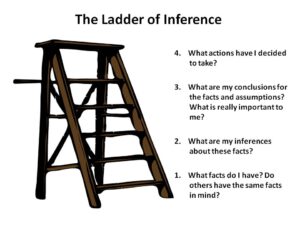Using an old trick for more effective meeting participation working from home
We have been in some sort of lockdown or other due to the pandemic for a year now. This situation allowed or forced –depending on personal preference– a lot of people to work from home. Recent studies published by PwC show that working from home is mostly seen as a success (by 71% of employees, and 83% of employers). However, after the first months of excitement some of the downsides became more evident too. One of them is obviously the lack of social contact and informal exchange with colleagues which used to happen at coffee machines, in cafeterias or over lunch in canteens. To compensate for the lack of direct interaction even before the pandemic I had already suggested to virtual leaders setting up a virtual coffee corner to get-together and socialise with their team members (see here).

The pandemic within the pandemic
One more work-related downsides of working from home has been surfacing more often in conversations I have had with my clients in recent weeks. It is about the pandemic of meeting requests filling up diaries to a point that work hours have to get extended to get all the other work done. The biggest frustration voiced very often is that people are called into meetings for a prolonged time in which they have only a short slot to contribute. And yet they are invited and expected to be present for the whole time. And in some cases, the person does not even get the time to talk about his/her subject as the agenda was overloaded. Some time ago I have also written a blog about how to create engaging meetings. And creating an appropriate agenda was one of the aspects I covered (see here).
The old trick
Reflecting all this in a recent coaching conversation with a leader an idea emerged which reminded me of an approach that had been used when I was still in an active leadership role over 20 years ago, to save people’s time and make meeting participation more effective. In those days meeting agendas particularly for project review meetings were planned in a way that particular functions were called in at an appropriate time for their slot to be presented and discussed. Of course, agendas weren’t always kept precisely on time even back then, so one was regularly joining too early, but it still saved time as you had no obligation to be present for the whole meeting if you only had an input in a small part of it.
Why not reapplying?
With that in mind I smiled when this idea popped up as nowadays it is much easier logistically to join a virtual meeting and leave when you’re done – as there is no ‘trip across a site’ involved any longer. You do not even have to leave your desk anymore. Why have we forgotten about this approach? Is it because organisers of meetings believe that everybody must be present at any time to be fully in the picture or is it just a thoughtless automatic reflex to invite everybody for the full meeting?
The online meeting advantage
So here is my advice: when you prepare the agenda for your next meeting think very thoroughly who would need to be present for what part to not only have an effective meeting but make the most efficient use of everyone’s time. Clarify this with all participants and leave it up to them to join earlier and leave later if they want to do so. In that way you leave the responsibility for the time management with each person rather than being too prescriptive about how they spend their day. Looking from the other end, as a participant, ask organisers of meetings at what time they expect your point to be on the agenda for you to join the meeting in time. You could even agree that they would text you when it is your turn to present or join the discussion.
One of my clients who started doing exactly that received incredibly positive feedback from people involved about the increased effectiveness and efficiency of their time management.
And as a byproduct, chances are, the meeting agenda gets organised and planned better to start with.
Conclusion
Having everybody for all agenda items in a meeting can be a massive waste of time! Rethink your approach how you are planning meeting agendas and invite people to make meetings effective and time consumption efficient for all participants. Consider providing specific slots for different parts of the meeting so people can join when needed and leave when their presence is no longer required. You will be surprised how grateful people will be for this approach.
And as always, if you are interested to explore this further, please …



